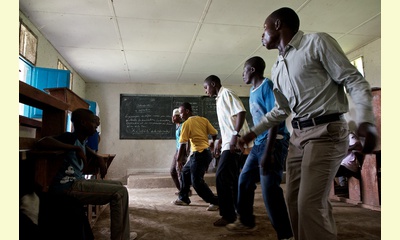|
|
Local Voices Saying No to War in North Kivu
un articulo por Alexis Bouvy for Search for Common Ground (abridged)
Despite the fact that their friends or parents
have joined local militia groups, the young people
from JMTAP, the Youth Musical and Theatrical
Alliance for Peace, fight daily for peace and
peaceful coexistence in North Kivu. This is a
brave undertaking, carried out with an
extraordinary energy, in areas where there are
deadly confrontations between armed groups and
intercommunity tensions remain high.

JMTAP members rehearsing a choreography
click on photo to enlarge
In the rural areas of North Kivu, young people
play a key role in armed conflict. Often despite
themselves, many young people find themselves to
be participants in the war as well as victims of
it. Young people are often the first to be
targeted when the time comes to recruit men for
the militias. They make up a substantial number of
the troops who fight – and die – on the different
frontlines in North Kivu. Moreover, the majority
of young civilians have friends, acquaintances or
parents who join one or another of the armed
groups. . .
Despite the difficult environment, some young
people from different local communities decided to
come together to fight for peace and peaceful
coexistence. In Nyabiondo, JMTAP, the Youth
Musical and Theatrical Alliance for Peace, brings
together more than 60 young people, aged between
16 and 25, and full of energy and enthusiasm for
the cause. These young people from Nyabiondo
decided to set up JMTAP after ‘Cheka’s war’ in
2012, in which Cheka’s group (from the Nyanga
community) fought the APCLS group (from the Hunde
community). Achille, the young President of JMTAP,
tells us “Discrimination between the Hunde and the
Nyanga was very strong at that time. Each
community wanted revenge on the other for all the
losses that they had sustained during the
fighting!”
When the JMTAP members decided to organise peace
performances with their limited means, more than
50 young people came together in the main street
of Nyabiondo or in neighbouring villages, reciting
poems, singing songs and putting on plays with the
theme of repudiating the ideology of war and
ethnic division. The villagers found it hard to
resist. Achille tells us “During our last
performance in Bukombo, the people were very happy
with our show and with the message. They were very
grateful!” . . .
Achille, JMTAP’s President, Justin, his Vice-
President, and Fidéline, one of the group’s
advisors, tell us about the problems for young
people facing the armed groups. They give us their
opinions on the relationships between the local
communities, but also on the relations between the
countries in the region. Finally they tell us
about the problems that they have experienced
through running the JMTAP activities. . .
Every Thursday afternoon, after school, the JMTAP
members get together at the Nyabiondo Institute to
dance and prepare their songs, poems and drama
sketches. Local Voices was lucky enough to attend
one of these rehearsals during which the young
people performed their own song with explosive
lyrics about the armed conflict and the need for
peace in DRC.
|








|
DISCUSSION
Pregunta(s) relacionada(s) al artículo :
Can you add to this analysis of the Democratic Republic of the Congo?,
* * * * *
Comentario más reciente:
Evolution of the Peace Process in the Democratic Republic of Congo
submitted to CPNN in French by Solidarité avec les Victimes et pour la Paix and translated into English by CPNN
For the original article in French, see RDC Solidarite.
From the recent past to today
After the armed hostilities in 1996 and the fall of Mobutu in May 17, 1997, there was a period of relative calm for fourteen months. A new rebellion began on August 2, 1998. Very early, negotiations started in Lusaka (Zambia) and arrived at the first agreements of ceasefire dated from July 10, 1999. It was to oversee respect of these agreements of Lusaka that the Security Council of the United Nations set up its resolution creating the Observation Mission of the United Nations (MONUC).
It was in October 2006 that the first free elections were organized.
To establish an account of the situation is difficult, but it is easier to say that at the present time the effects of armed conflict are still sad at various levels. There is extreme poverty in the civilian population. Until the present a responsible solution has not been found to assure access of children to education.
Good news today is that the country now has a Constitution, a President of the Republic, a Parliament and a Senate and provincial assemblies as well as provincial governments following the democratic elections organized in 2007. In general, the Democratic Republic of Congo is arriving slowly at peace and stability despite the constraints of reconstruction and restoration of a state of law.
Without pretending to be exhaustive, this report is a description of human rights violations on the civilian population in the city of Kinshasa. Acts of torture continue to take place. . ... continuación.

|
|









